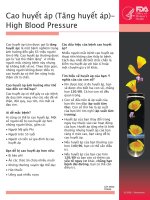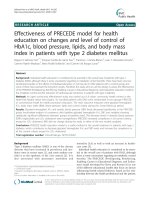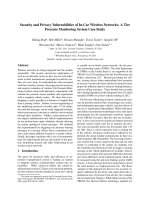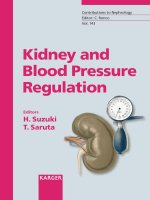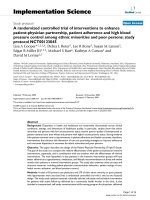Blood Pressure Monitoring
Bạn đang xem bản rút gọn của tài liệu. Xem và tải ngay bản đầy đủ của tài liệu tại đây (267.49 KB, 24 trang )
B
BLOOD PRESSURE MONITORING
SURGICAL CRITICAL CARE VIVAS
᭢
38
BLOOD PRESSURE MONITORING
Define the blood pressure.
Blood pressure is defined as the product of the cardiac out-
put and the systemic vascular resistance. The cardiac output is
the product of the heart rate and stroke volume.
In which ways can blood pressure be measured?
Blood pressure can be measured non-invasively with a sphyg-
momanometer, or invasively by direct cannulation of a periph-
eral artery. This latter method gives a continuous waveform
trace after attachment to an electronic pressure transducer.
Draw the blood pressure waveform.
120
Dicrotic
notch
Systolic
Arterial pressure waveform
Diastolic
80
mmHg
The ‘dicrotic notch’ is a momentary rise in the arterial pres-
sure trace following closure of the aortic valve.
How is the mean blood pressure calculated?
The area beneath the arterial pressure wave tracing represents
the mean arterial pressure. For the purposes of simplicity, it
may be calculated by the formula
Pd ϩ (Ps Ϫ Pd)/3
where Pd ϭ diastolic pressure and Ps ϭ systolic pressure.
What is Allen’s test, and how is it performed?
Allen’s test is a test of the competence of the collateral circu-
lation of the hand – and may be used practically to determine
SURGICAL CRITICAL CARE VIVAS
B
BLOOD PRESSURE MONITORING
᭢
39
if the ulnar artery supply to the hand is able to cope in the
face of an absent radial artery, e.g. when considering the use
of the radial artery as a vascular conduit for bypass surgery.
The examiner occludes the blood f low to the hand while the
patient drains the hand of blood by repeatedly opening and
closing the fist. The hand is then held open while the ulnar
f low is released. The test is considered positive if the hand is
still blanched after 15 s, suggesting that the ulnar artery alone
is not able to sufficiently supply the hand.
What are the complications of arterial lines, and
what are the contra-indications to their
insertion?
The complications include
᭹
Most commonly:
Haematoma formation
Digital ischaemia due to vascular injury or accidental
injection of drugs
᭹
Less commonly:
Infection
Pseudoaneurysm formation
Arteriovenous fistula formation
Exsanguination from a disconnected line
It is contra-indicated in those with digital vasculitis, and in
those patients who are going to have the artery of that side
harvested as a conduit for bypass surgery.
What is meant by the term ‘swing in the arterial line’
during continuous measurements, and what is its
significance?
This term refers to a variation of the amplitude in the arterial
tracing with the respiratory cycle. It is an indicator that the
patient is underfilled and requires more f luid resuscitation.
B
BLOOD PRESSURE MONITORING
SURGICAL CRITICAL CARE VIVAS
᭢
40
How does the arterial pressure at the radial artery
compare to that at the aortic root, what accounts for
this difference?
Both the pressure values and waveform change at different
levels of the circulation. In the radial artery, the systolic pressure
is about 10 mmHg higher and the diastolic pressure about
10 mmHg lower than in the aortic root. Consequently, although
the pulse pressure is higher in the radial artery, the mean arte-
rial pressure is about 5 mmHg lower than in the aortic root.
These differences are, in part, due to changes in wall stiffness
along the arterial tree, and its consequent effects on the trans-
mission of the pulse wave along the vessel.
Adapted from "Circulatory Physiology"
3rd edition by Smith & Kampire p 93
Published by Williams & Wilkins
ISBN 0683077759
150
100
50
Ascending aorta
114
Mean 93
83
126
71
150
100
50
Radial Artery
Pressure (mmHg)
Mean 89
Pressure waves at different sites in the arterial tree. With
transmission of the pressure wave into the distal aorta
and large arteries, the systolic pressure increases and the
diastolic pressure decreases, with a resultant heightening
of the pulse pressure. However, the mean arterial
pressure declines steadily.
SURGICAL CRITICAL CARE VIVAS
B
BLOOD PRESSURE MONITORING
41
How does the arterial pressure waveform differ with
diseases of the aortic valve?
᭹
Aortic stenosis: Anacrotic pulse – slow to rise and of low
amplitude
᭹
Aortic incompetence: Waterhammer pulse – rapid rise and
decline, attaining high amplitude
᭹
Mixed aortic valve disease: Pulsus bisferiens – a large
amplitude pulse with a ‘double peak’, often felt as a
double pulse at the brachial artery
What is pulsus paradoxus?
Pulsus paradoxus is an exaggerated (Ͼ10 mmHg) reduction
of the arterial pressure brought on by inspiration, and may be
seen in cardiac tamponade. The normal increase in the
venous return brought on by inspiration coupled with a tight
pericardial space leads to a reduction of the left ventricular
end diastolic volume, and hence, stroke volume.
What is pulsus alterans?
Pulsus alterans is a random variation in the amplitude of the
arterial pressure tracing with each cardiac cycle, and is seen
with left ventricular failure.
B
BLOOD PRODUCTS
SURGICAL CRITICAL CARE VIVAS
᭢
42
BLOOD PRODUCTS
What blood products do you know of other than red
cells?
The other major blood products are
᭹
Plasma-derived
Fresh frozen plasma (FFP)
Human albumin solution
Immunoglobulins
Individual factor concentrates, e.g. factors VII,VIII, IX, X,
prothrombin complex, antithrombin III
Cryoprecipitate
Note that FFP may be fractionated into the products listed
below it.
᭹
Platelet concentrates
How are platelets stored once collected?
Platelets do not function at low temperatures, so that once
collected, they are stored at room temperature of 20–24°C
on a special agitator.
What is the shelf life of platelets?
This is 5–7 days if sealed in special packaging that permits
atmospheric oxygenation.
How many platelets are obtained from each
donation?
Each platelet donation contains 55 ϫ 10
9
platelets. When
pooled together to form an adult dose, about 240 ϫ 10
9
platelets can be obtained.
Give some indications for a platelet transfusion.
These are basically
᭹
Any cause of thrombocytopenia, when the count falls below
50 ϫ 10
9
/l
᭹
Note that the above includes disseminated intravascular
coagulation
SURGICAL CRITICAL CARE VIVAS
B
BLOOD PRODUCTS
᭢
43
᭹
Post cardiopulmonary bypass: It is known that this has a
direct detrimental effect on platelet function. Also,
patients coming off bypass may still have a low body
temperature, which reduces platelet function. They may
also have taken aspirin up to the time of surgery.
Platelets may in these instances be required to control
bleeding even though the platelet count may not be
that low
What are the problems associated with platelet
transfusion?
᭹
Risk of infection: as for a transfusion of packed red
cells
᭹
Rhesus sensitisation: Rh negative females under the age of
45 should receive Rh-D negative platelets
᭹
Alloimmunisation: this is due to development of
antibodies to HLA class I antigens. It can lead to a febrile
transfusion reaction and ‘refractoriness’ to therapy, when
the platelet count rises less than expected following a
transfusion
What are the two main components of FFP?
The two main components are cryoprecipitate and cryosu-
pernatant. Taken together, they are a rich source of all of the
clotting factors, von Willebrand factor, f ibrinogen, and other
plasma proteins.
How is FFP stored and what is the shelf life?
FFP is stored at Ϫ30°C for up to 12 months. Once thawed,
it should be transfused immediately to prevent the loss of the
labile factors V and VIII.
What is the dose of FFP?
The dose of FFP is weight-dependent, and a typical starting
dose is 10–15 ml/kg.
B
BLOOD PRODUCTS
SURGICAL CRITICAL CARE VIVAS
᭢
44
Give some indications for its (FFP) use.
᭹
Reversal of warfarin effect
᭹
Help control intra-operative/post-operative bleeding,
e.g. after cardiac surgery
᭹
Following massive blood transfusion
᭹
Disseminated intravascular coagulation
᭹
Those with antithrombin III deficiency and resistance to
heparinisation
What components is cryoprecipitate particularly
rich in?
Cryoprecipitate is a rich source of fibrinogen, f ibronectin,
factors VIII, XIII (f ibrin-stabilising factor), and von Willebrand
factor.
What is the management of warfarin overdose?
The management of warfarin overdose depends on the severity
of the blood loss and the international normalised ratio (INR).
᭹
If the INR is Ͼ4.5 with no haemorrhage, the warfarin
can be omitted for 1–2 days followed by a review
᭹
If haemorrhage is not severe, warfarin may again be
omitted, and if indicated clinically, reversed with a slow
i.v. infusion of vitamin K, 0.5–2.0 mg
᭹
In the face of severe haemorrhage, 5 mg of vitamin K is
given by slow i.v. infusion together with prothrombin
complex concentrate (PCC), containing factors II, IX
and X with factor VII. Alternatively, FFP can be given,
but may be less effective than PCC
᭹
These guidelines are based on the advice of the ‘Handbook
of Transfusion Medicine’ published by Her Majesty’s
Stationery Office (HMSO)
What types of human albumin are available?
Human albumin solution is available as either a 4.5% or 20%
solution. The latter is also known as ‘salt-poor albumin’ since it
contains less sodium.
SURGICAL CRITICAL CARE VIVAS
B
BLOOD PRODUCTS
45
What is the use of this blood product?
Some uses for human albumin
᭹
Management of ascites in portal hypertension
᭹
Oedema due to other causes of hypoalbuminaemia such
as the nephrotic syndrome
᭹
As a plasma expander in hypovolaemic shock: there is no
evident superiority over other colloids or crystalloids in
this situation
B
BLOOD TRANSFUSION
SURGICAL CRITICAL CARE VIVAS
᭢
46
BLOOD TRANSFUSION
What is the purpose of a blood transfusion?
To restore the circulating volume in order to improve tissue
perfusion and to maintain an adequate blood oxygen
carrying capacity.
What is the volume of a unit of packed red cells?
280 Ϯ 60 ml.
At what temperature is the blood stored?
2–6°C.
What is the shelf life of blood?
35 days, at the correct storage temperature.
What are the additive solutions and what is their
purpose?
The most common additive solutions are
᭹
CAPD: Citrate, Adenine, Phosphate, and Dextrose
᭹
SAMG: Saline, Adenine, Mannitol, and Glucose
The additive solutions are used to re-suspend the packed cells
after the plasma has been removed, and they maintain the
cells in a good condition during storage.
What is the expected increase in the haemoglobin
concentration [Hb] following a transfusion of packed
red cells?
A 4 ml/kg dose of packed cells raises the [Hb] by 1 g/dl.
What is the estimated blood volume in an adult and
a child?
The estimated blood volume in an adult is 70 ml/kg, in a
child is 80 ml/kg.
